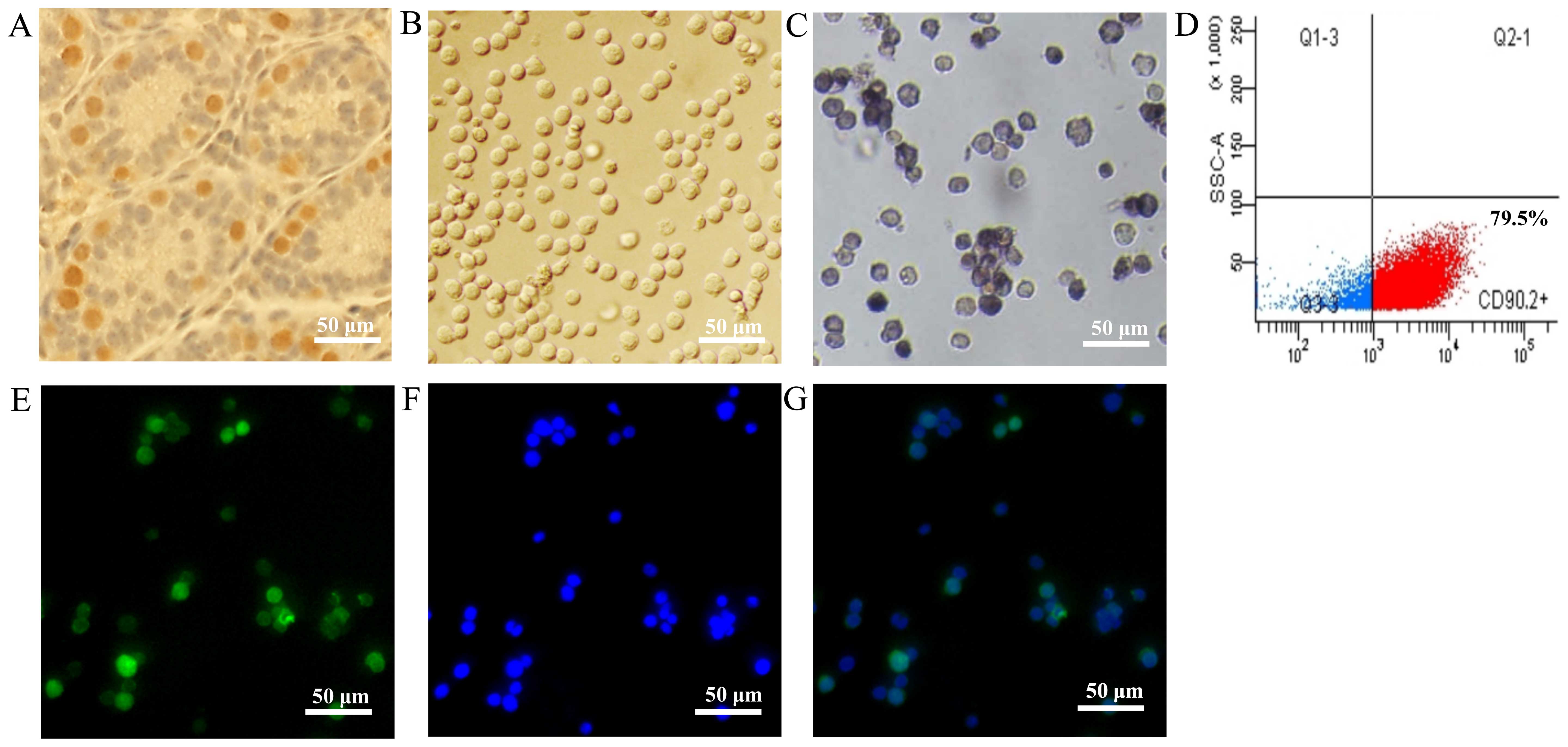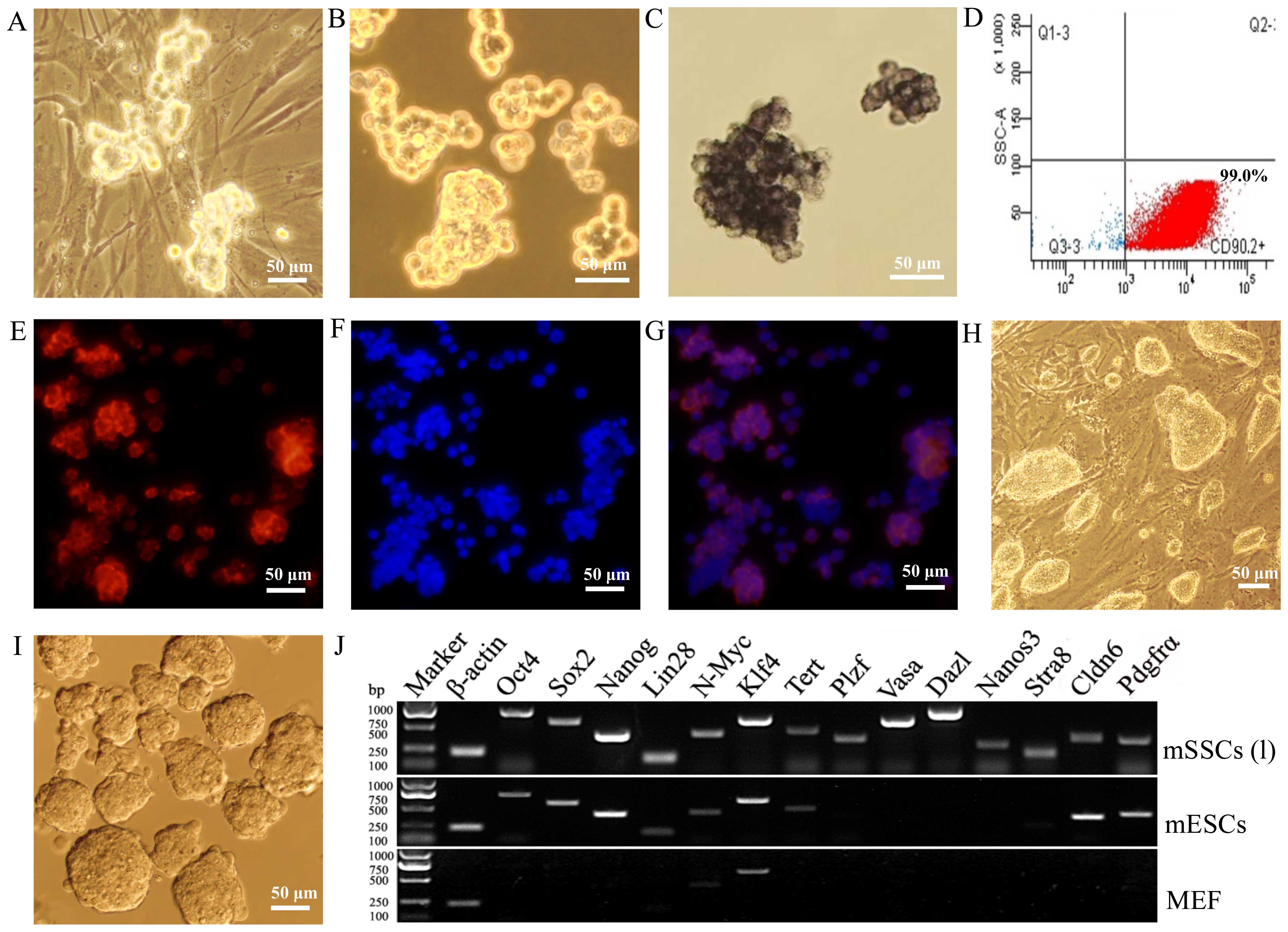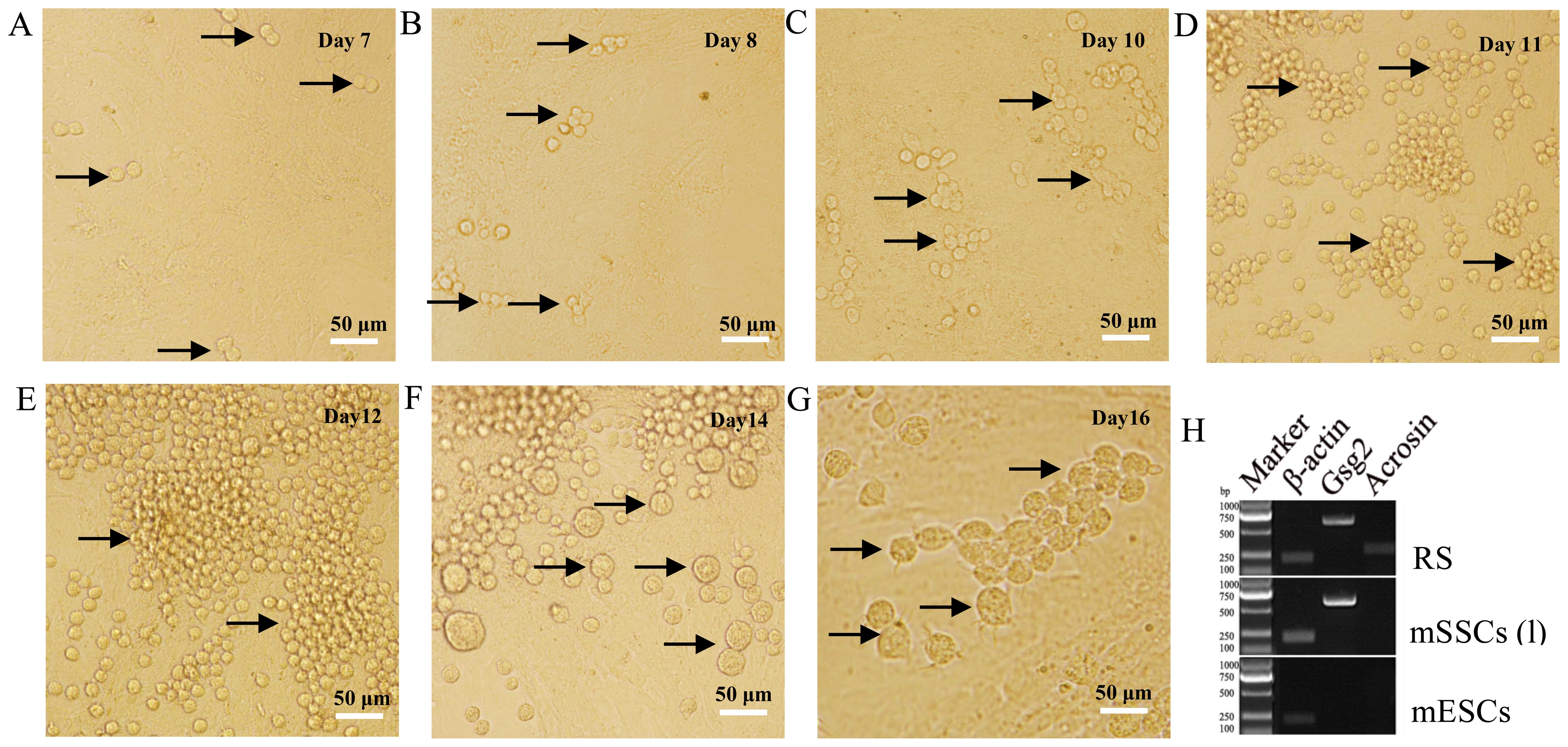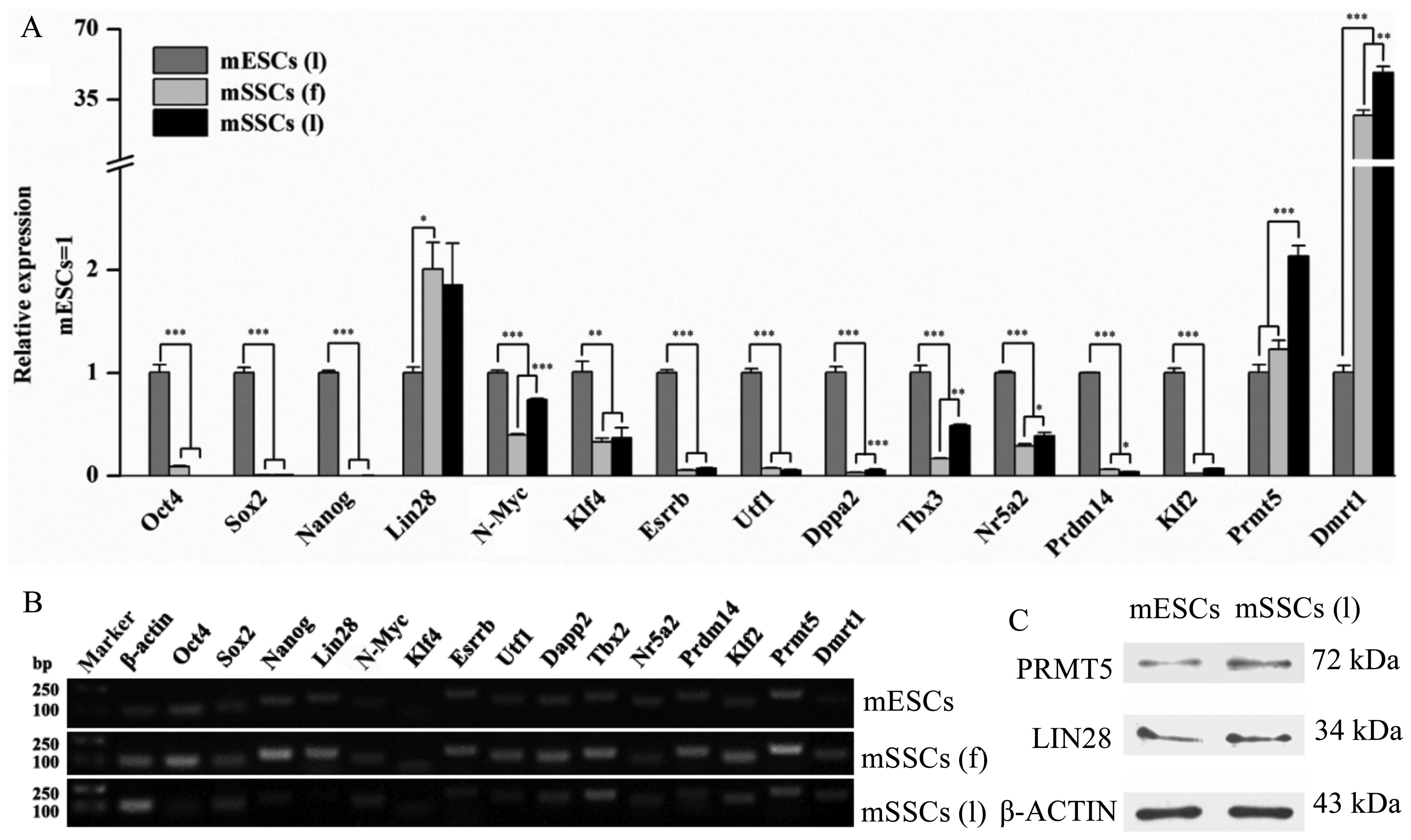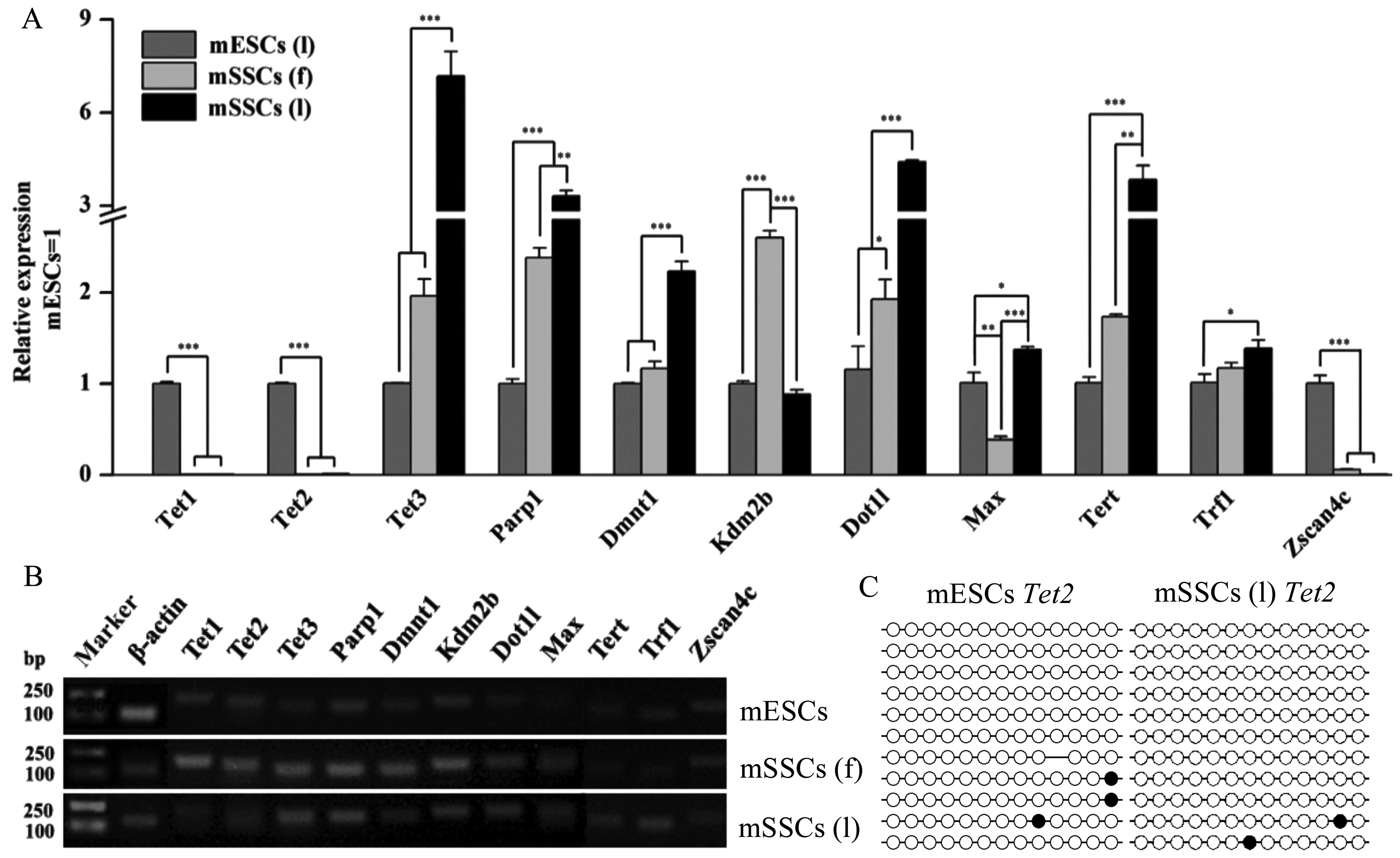|
1
|
Pirouz M, Klimke A and Kessel M: The
reciprocal relationship between primordial germ cells and
pluripotent stem cells. J Mol Med Berl. 90:753–761. 2012.
View Article : Google Scholar : PubMed/NCBI
|
|
2
|
Kim HJ, Lee HJ, Lim JJ, Kwak KH, Kim JS,
Kim JH, Han YM, Kim KS and Lee DR: Identification of an
intermediate state as spermatogonial stem cells reprogram to
multipotent cells. Mol Cells. 29:519–526. 2010. View Article : Google Scholar : PubMed/NCBI
|
|
3
|
Saitou M, Kagiwada S and Kurimoto K:
Epigenetic reprogramming in mouse pre-implantation development and
primordial germ cells. Development. 139:15–31. 2012. View Article : Google Scholar
|
|
4
|
Gifford CA, Ziller MJ, Gu H, Trapnell C,
Donaghey J, Tsankov A, Shalek AK, Kelley DR, Shishkin AA, Issner R,
et al: Transcriptional and epigenetic dynamics during specification
of human embryonic stem cells. Cell. 153:1149–1163. 2013.
View Article : Google Scholar : PubMed/NCBI
|
|
5
|
Orkin SH and Hochedlinger K: Chromatin
connections to pluripotency and cellular reprogramming. Cell.
145:835–850. 2011. View Article : Google Scholar : PubMed/NCBI
|
|
6
|
Takahashi K and Yamanaka S: Induction of
pluripotent stem cells from mouse embryonic and adult fibroblast
cultures by defined factors. Cell. 126:663–676. 2006. View Article : Google Scholar : PubMed/NCBI
|
|
7
|
Onder TT, Kara N, Cherry A, Sinha AU, Zhu
N, Bernt KM, Cahan P, Marcarci BO, Unternaehrer J, Gupta PB, et al:
Chromatin-modifying enzymes as modulators of reprogramming. Nature.
483:598–602. 2012. View Article : Google Scholar : PubMed/NCBI
|
|
8
|
Kurosaki H, Kazuki Y, Hiratsuka M, Inoue
T, Matsui Y, Wang CC, Kanatsu-Shinohara M, Shinohara T, Toda T and
Oshimura M: A comparison study in the proteomic signatures of
multipotent germline stem cells, embryonic stem cells, and germline
stem cells. Biochem Biophys Res Commun. 353:259–267. 2007.
View Article : Google Scholar
|
|
9
|
Fujino RS, Ishikawa Y, Tanaka K,
Kanatsu-Shinohara M, Tamura K, Kogo H, Shinohara T and Hara T:
Capillary morphsx-ogenesis gene (CMG)-1 is among the genes
differentially expressed in mouse male germ line stem cells and
embryonic stem cells. Mol Reprod Dev. 73:955–966. 2006. View Article : Google Scholar : PubMed/NCBI
|
|
10
|
Takashima S, Hirose M, Ogonuki N, Ebisuya
M, Inoue K, Kanatsu-Shinohara M, Tanaka T, Nishida E, Ogura A and
Shinohara T: Regulation of pluripotency in male germline stem cells
by Dmrt1. Genes Dev. 27:1949–1958. 2013. View Article : Google Scholar : PubMed/NCBI
|
|
11
|
Kubota H, Avarbock MR and Brinster RL:
Culture conditions and single growth factors affect fate
determination of mouse spermatogonial stem cells. Biol Reprod.
71:722–731. 2004. View Article : Google Scholar : PubMed/NCBI
|
|
12
|
Hu M, Wei H, Zhang J, Bai Y, Gao F, Li L
and Zhang S: Efficient production of chimeric mice from embryonic
stem cells injected into 4- to 8-cell and blastocyst embryos. J
Anim Sci Biotechnol. 4:122013. View Article : Google Scholar : PubMed/NCBI
|
|
13
|
Zhang X, Li L, Bai Y, Shi R, Wei H and
Zhang S: Mouse undifferentiated spermatogonial stem cells cultured
as aggregates under simulated microgravity. Andrologia.
46:1013–1021. 2014. View Article : Google Scholar : PubMed/NCBI
|
|
14
|
Godmann M, May E and Kimmins S: Epigenetic
mechanisms regulate stem cell expressed genes Pou5f1 and Gfra1 in a
male germ cell line. PLoS One. 5:e127272010. View Article : Google Scholar : PubMed/NCBI
|
|
15
|
Wang L, Xue Y, Shen Y, Li W, Cheng Y, Yan
X, Shi W, Wang J, Gong Z, Yang G, et al: Claudin 6: A novel surface
marker for characterizing mouse pluripotent stem cells. Cell Res.
22:1082–1085. 2012. View Article : Google Scholar : PubMed/NCBI
|
|
16
|
Eberhart JK, He X, Swartz ME, Yan YL, Song
H, Boling TC, Kunerth AK, Walker MB, Kimmel CB and Postlethwait JH:
MicroRNA Mirn140 modulates Pdgf signaling during palatogenesis. Nat
Genet. 40:290–298. 2008. View
Article : Google Scholar : PubMed/NCBI
|
|
17
|
Ventelä S, Mäkelä JA, Kulmala J,
Westermarck J and Toppari J: Identification and regulation of a
stage-specific stem cell niche enriched by Nanog-positive
spermatogonial stem cells in the mouse testis. Stem Cells.
30:1008–1020. 2012. View Article : Google Scholar : PubMed/NCBI
|
|
18
|
Kim J, Chu J, Shen X, Wang J and Orkin SH:
An extended transcriptional network for pluripotency of embryonic
stem cells. Cell. 132:1049–1061. 2008. View Article : Google Scholar : PubMed/NCBI
|
|
19
|
Yu J, Vodyanik MA, Smuga-Otto K,
Antosiewicz-Bourget J, Frane JL, Tian S, Nie J, Jonsdottir GA,
Ruotti V, Stewart R, et al: Induced pluripotent stem cell lines
derived from human somatic cells. Science. 318:1917–1920. 2007.
View Article : Google Scholar : PubMed/NCBI
|
|
20
|
Buganim Y, Faddah DA, Cheng AW, Itskovich
E, Markoulaki S, Ganz K, Klemm SL, van Oudenaarden A and Jaenisch
R: Single-cell expression analyses during cellular reprogramming
reveal an early stochastic and a late hierarchic phase. Cell.
150:1209–1222. 2012. View Article : Google Scholar : PubMed/NCBI
|
|
21
|
Han J, Yuan P, Yang H, Zhang J, Soh BS, Li
P, Lim SL, Cao S, Tay J, Orlov YL, et al: Tbx3 improves the
germ-line competency of induced pluripotent stem cells. Nature.
463:1096–1100. 2010. View Article : Google Scholar : PubMed/NCBI
|
|
22
|
Tay YM, Tam WL, Ang YS, Gaughwin PM, Yang
H, Wang W, Liu R, George J, Ng HH, Perera RJ, et al: MicroRNA-134
modulates the differentiation of mouse embryonic stem cells, where
it causes post-transcriptional attenuation of Nanog and LRH1. Stem
Cells. 26:17–29. 2008. View Article : Google Scholar
|
|
23
|
Heng JC1, Feng B, Han J, Jiang J, Kraus P,
Ng JH, Orlov YL, Huss M, Yang L, Lufkin T, et al: The nuclear
receptor Nr5a2 can replace Oct4 in the reprogramming of murine
somatic cells to pluripotent cells. Cell Stem Cell. 6:167–174.
2010. View Article : Google Scholar : PubMed/NCBI
|
|
24
|
Gillich A, Bao S, Grabole N, Hayashi K,
Trotter MW, Pasque V, Magnúsdóttir E and Surani MA: Epiblast stem
cell-based system reveals reprogramming synergy of germline
factors. Cell Stem Cell. 10:425–439. 2012. View Article : Google Scholar : PubMed/NCBI
|
|
25
|
Nagamatsu G, Kosaka T, Kawasumi M,
Kinoshita T, Takubo K, Akiyama H, Sudo T, Kobayashi T, Oya M and
Suda T: A germ cell-specific gene, Prmt5, works in somatic cell
reprogramming. J Biol Chem. 286:10641–10648. 2011. View Article : Google Scholar : PubMed/NCBI
|
|
26
|
Zhong X, Li N, Liang S, Huang Q, Coukos G
and Zhang L: Identification of microRNAs regulating reprogramming
factor LIN28 in embryonic stem cells and cancer cells. J Biol Chem.
285:41961–41971. 2010. View Article : Google Scholar : PubMed/NCBI
|
|
27
|
Yang J, van Oosten AL, Theunissen TW, Guo
G, Silva JC and Smith A: Stat3 activation is limiting for
reprogramming to ground state pluripotency. Cell Stem Cell.
7:319–328. 2010. View Article : Google Scholar : PubMed/NCBI
|
|
28
|
Tee WW, Pardo M, Theunissen TW, Yu L,
Choudhary JS, Hajkova P and Surani MA: Prmt5 is essential for early
mouse development and acts in the cytoplasm to maintain ES cell
pluripotency. Genes Dev. 24:2772–2777. 2010. View Article : Google Scholar : PubMed/NCBI
|
|
29
|
Doege CA, Inoue K, Yamashita T, Rhee DB,
Travis S, Fujita R, Guarnieri P, Bhagat G, Vanti WB, Shih A, et al:
Early-stage epigenetic modification during somatic cell
reprogramming by Parp1 and Tet2. Nature. 488:652–655. 2012.
View Article : Google Scholar : PubMed/NCBI
|
|
30
|
Deplus R, Delatte B, Schwinn MK, Defrance
M, Méndez J, Murphy N, Dawson MA, Volkmar M, Putmans P, Calonne E,
et al: TET2 and TET3 regulate GlcNAcylation and H3K4 methylation
through OGT and SET1/COMPASS. EMBO J. 32:645–655. 2013. View Article : Google Scholar : PubMed/NCBI
|
|
31
|
Villani P, Fresegna AM, Ranaldi R,
Eleuteri P, Paris L, Pacchierotti F and Cordelli E: X-ray induced
DNA damage and repair in germ cells of PARP1(−/−) male mice. Int J
Mol Sci. 14:18078–18092. 2013. View Article : Google Scholar : PubMed/NCBI
|
|
32
|
Liang G, He J and Zhang Y: Kdm2b promotes
induced pluripotent stem cell generation by facilitating gene
activation early in reprogramming. Nat Cell Biol. 14:457–466. 2012.
View Article : Google Scholar : PubMed/NCBI
|
|
33
|
He J, Shen L, Wan M, Taranova O, Wu H and
Zhang Y: Kdm2b maintains murine embryonic stem cell status by
recruiting PRC1 complex to CpG islands of developmental genes. Nat
Cell Biol. 15:373–384. 2013. View Article : Google Scholar : PubMed/NCBI
|
|
34
|
Chen J, Liu H, Liu J, Qi J, Wei B, Yang J,
Liang H, Chen Y, Chen J, Wu Y, et al: H3K9 methylation is a barrier
during somatic cell reprogramming into iPSCs. Nat Genet. 45:34–42.
2013. View Article : Google Scholar
|
|
35
|
Maeda I, Okamura D, Tokitake Y, Ikeda M,
Kawaguchi H, Mise N, Abe K, Noce T, Okuda A and Matsui Y: Max is a
repressor of germ cell-related gene expression in mouse embryonic
stem cells. Nat Commun. 4:17542013. View Article : Google Scholar : PubMed/NCBI
|
|
36
|
Schneider RP, Garrobo I, Foronda M,
Palacios JA, Marión RM, Flores I, Ortega S and Blasco MA: TRF1 is a
stem cell marker and is essential for the generation of induced
pluripotent stem cells. Nat Commun. 4:19462013.PubMed/NCBI
|
|
37
|
Zalzman M, Falco G, Sharova LV, Nishiyama
A, Thomas M, Lee SL, Stagg CA, Hoang HG, Yang HT, Indig FE, et al:
Zscan4 regulates telomere elongation and genomic stability in ES
cells. Nature. 464:858–863. 2010. View Article : Google Scholar : PubMed/NCBI
|
|
38
|
Winkler T, Hong SG, Decker JE, Morgan MJ,
Wu C, Hughes WM, Yang Y, Wangsa D, Padilla-Nash HM, Ried T, et al:
Defective telomere elongation and hematopoiesis from
telomerase-mutant aplastic anemia iPSCs. J Clin Invest.
123:1952–1963. 2013. View Article : Google Scholar : PubMed/NCBI
|
|
39
|
Jiang J, Lv W, Ye X, Wang L, Zhang M, Yang
H, Okuka M, Zhou C, Zhang X, Liu L and Li J: Zscan4 promotes
genomic stability during reprogramming and dramatically improves
the quality of iPS cells as demonstrated by tetraploid
complementation. Cell Res. 23:92–106. 2013. View Article : Google Scholar :
|



